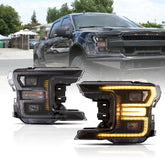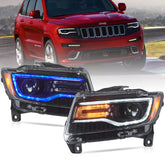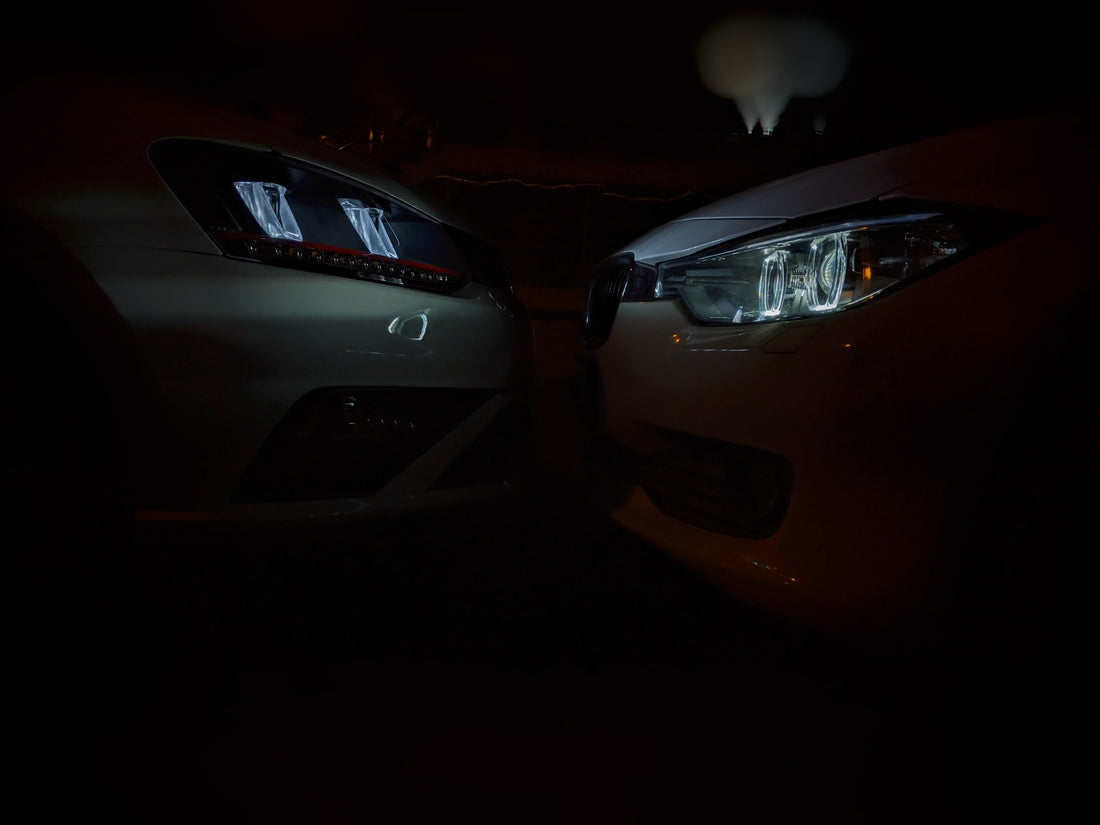Innovations in Automotive Lighting Design
Almost all OEMs have incorporated LED technology in today’s vehicles. LED daytime running lights and rear lights have been introduced on a number of vehicles, and the latest LED matrix headlights provide vastly superior characteristics for functionality and design. Safety, reliability and cost are always at the forefront of automotive design, but the flexibility of LED and OLED technology also provides far greater freedom of design in terms of brand and image.
This has extended to the interior of cars as well, where OEMs are beginning to introduce fascinating lighting concepts to improve comfort, safety, styling and brand recognition within their vehicles. LED lights that can change color and brightness, and are small enough to be installed in a range of configurations have enabled designers to illuminate interiors in previously unimaginable ways. Whether functional lighting to warn pedestrians or the driver of a situation, or ambient lighting in the footwell, door panels and roof, new ideas and applications are coming to the fore with every passing month. This article will look at some of the latest technologies on the road, and some of the most innovative concepts set to hit the market in the next few years.

Audi keeps pushing on
Audi has been one of the most forward-thinking OEMs in lighting innovation, creating a range of concepts for interior and exterior using both LED and OLED technology.
Interior lighting design is based on the mood and safety of the driver and passengers, with surfaces and panels illuminated by carefully deployed lighting. Traditionally, Audi has used cool, ‘technical-looking’ lighting and color schemes to accentuate the character of the brand, but in the Q7 it has provided the option for the driver to change the color of the ambient lighting to suit. A choice of 32 colors is available for the ambient lighting and the ‘marker’ light - extremely narrow light guides that trace the contours of the instrument panel, the doors and the center console.
These marker lights are not just for changing the mood, they also work intelligently with Audi’s Exit Warning assistance system. If the driver or a passenger tries to open the door in a situation where traffic is approaching from the rear, the light guide lights up in signal red and pulses at short intervals to act as a warning. Future concepts due to enter production surround the idea of interaction with the driver, and light serving as a warning system. LED lights backlight the decorative inlay on the center console, the doors and the instrument panel. These will act as warnings when exiting the vehicle or parking, and can be used to indicate the driving state. For example, if a driver initiates piloted driving in a traffic jam, parts of the steering wheel will light up green, but when the driver needs to take control again, the lights change to red to engage the driver.
[inlinead]
Delving further into OLED technology for interiors, Audi showcased OLED displays in its e-tron Quattro concept vehicle last year. The Audi Virtual Cockpit Curved OLED is a further development of the original Audi Virtual Cockpit that debuted in 2014. All displays in the vehicle use OLED technology. To the left and right below the fully digital instrument cluster are two OLED touch displays that control lights, systems for piloted driving, media and navigation. The steering wheel also serves as a control option, with its spokes equipped with contoured touch surfaces. Further OLED displays on the center console provide drive system status, climate control, and freely programmable information functions. Curved displays in the front section also serve as digital exterior mirrors.
HELLA showing dynamic lighting concept
HELLA has worked with Audi on the new A4, providing exterior and interior lighting with increased functionality. The roof module in the interior is equipped with a moonroof control and sensors for passenger compartment monitoring. The interior lighting can also be switched on and off or dimmed via a touchless switch function, where the driver can simply position their hand close to the interior lamp to activate the function.
In the last year HELLA has also showcased an innovative lighting concept in the Chevrolet Camaro. The concept gives the vehicle a distinctive design, as the color of the lighting changes slowly throughout the vehicle in a subtle, flowing pattern from the center screen.
The ambient lighting is controlled from the first navigation level of the infotainment system. From there the driver can directly select from 24 different colors, link the color of the interior lighting to the driving mode, or activate ‘show mode’. The color doesn’t change in a static fashion, but instead the light guides change systematically to create a dynamic change. Starting from the center screen, the color change moves from the cup holders to the doors in a continuous flow. The interior lights can also be linked to the driving mode to provide the correct mood. In ‘cruise mode’ a cool gentle blue is selected, while a strong orange complements ‘track mode’, and a red racing color supplements ‘sport mode’. ‘Show mode’ is a separate light show, which can be used in park mode, whereby the interior is illuminated in a variety of colors in a defined order.
A technical highlight of the concept is the fact that all of the interior colors match, despite the use of different materials. The light guide of the heads-up display is surrounded by a grey cover, which in daylight fuses into the black cover of the dashboard. At night, the light has the same effect as the other light guides in the interior lighting. This involved a complex calibration of LED modules during the production process, where colors were selected and sorted by intensity and brightness to produce a uniform appearance.
Mercedes is lighting up
Mercedes is another OEM that has invested heavily in LED and OLED technology, both for the interior and exterior of its vehicles. The 2017 E-Class features LED technology throughout the enhanced ambient lighting system.
There are 64 different colors to choose from, offering a host of possibilities for personalization. LED lighting has been incorporated into various trim parts, the center display, storage on the center console, handle recesses, door pockets, front and rear footwells, the overhead console, and tweeters.
Mercedes may also be ready to use OLED technology for display systems, as rumors earlier this year suggested the manufacturer is set to use LG Display’s 12.3” FHD flexible P-OLED displays for future E-Class models.
LG Display wants to conquer the automotive market
Back in 2014 LG Display announced its intention to enter the automotive display market, and earlier this year it unveiled its 12.3” full HD flexible OLED panels designed especially for the automotive market. The company is already collaborating with Tesla, Cadillac and Mercedes, although the panels are unlikely to enter production until 2018. As part of its strategy to become one of the largest suppliers of automotive displays, LG Display is also working on 25” curved and freeform automotive OLEDs, planned for 2019.
Beyond displays, LGD has also demonstrated its OLED light panels in collaboration with Korean car customizing company Chang’s Custom. OLED light panels were used to create the world’s first luxury van equipped with interior OLED lighting. Due to the thinness and flexibility of these light panels, this could be another area of innovation in the near future.
Ford is looking at psychological effects
Ford has taken a different approach to interior lighting with its Crystal Diamond Light concept that has debuted in the Ford F-150 and the new Ford Fusion. Its lighting concepts are based on psychology, as lighting inconsistencies and contrast irregularities can cause irritability and even depression.
The Crystal Diamond Light concept is designed to disperse broad, even lighting that can help reduce irritability while improving efficiency by up to 62% - lowering costs and enhancing aesthetics. The LED lighting enables fixtures to be miniaturized to enhance design aesthetics, while the diamond-like facets of the lens offer an even, broad distribution of light.
An era of new designs lies ahead
LED and OLED technologies are being introduced at greater levels and in a wider variety of designs than ever before. Human psychology and mood are key factors in design, as are concepts of safety and functionality.
Various car makers are moving towards using OLED display technology, and this is a pointer towards interiors of the future where displays and lighting concepts will seamlessly link together to create the interiors of the future. The flexibility of OLED means that it can be curved or shaped to suit any area and incorporated into any material. It’s an exciting time to be involved in automotive lighting, as these new technologies are leading to concepts and designs that were inconceivable with traditional vehicle lighting.

Sources:
https://www.audi-mediacenter.com/en/audi-at-ces-asia-2015-3701/lighting-technologies-3711
http://www.emercedesbenz.com/autos/mercedes-benz/e-class/2017-mercedes-benz-e-class-all-the-details/
http://www.lgoledlight.com/video/lg-display-oled-light-panels-for-automobile-interior-lighting.do
https://media.ford.com/content/fordmedia/fna/us/en/news/2016/02/24/ford-lights-up-the-night-with-psychology-guiding-the-way.pdf











